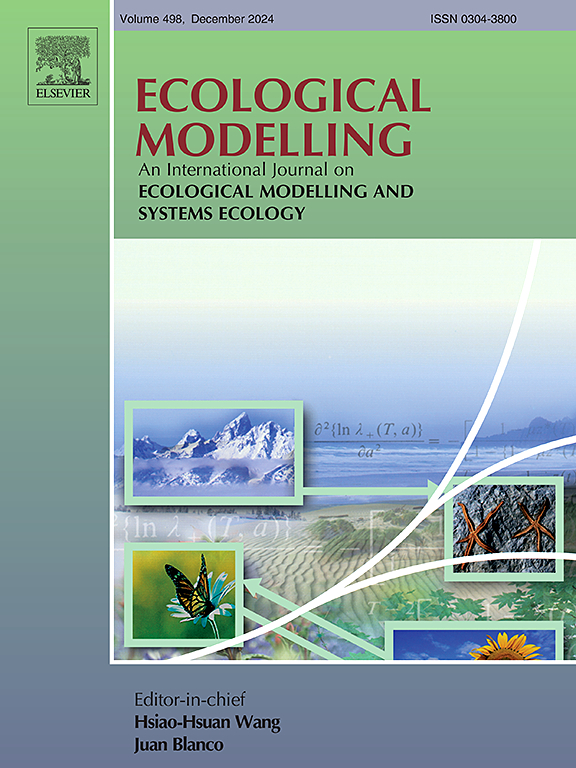模拟生物和环境因素对精细尺度珊瑚沉降模式的相互影响
IF 2.6
3区 环境科学与生态学
Q2 ECOLOGY
引用次数: 0
摘要
对于具有分散繁殖体的无根生物,繁殖体定居的栖息地在决定其定居后的生存中起着关键作用,这是种群维持和恢复的基础。珊瑚提供了一个有趣的例子,因为一系列生物物理定居线索,以及其他环境条件,如水流和栖息地分布,都会影响幼虫定居的地方。由于难以直接观察和测量微小(≤1毫米)幼虫在现场的扩散和沉降,这些过程相互作用影响珊瑚沉降空间格局的方式在很大程度上仍未得到探索。为了帮助解决这一知识差距,我们开发了一个机制模拟模型来探索三个首要因素(1)珊瑚礁基质的吸引力,(2)局部流体动力学和(3)珊瑚礁基质的空间分布)如何相互作用,以影响精细尺度(厘米到米)的空间沉降模式。通过情景探索,我们发现这三个因素之间的相互作用会导致不同的、有时违反直觉的聚落空间格局。通过模拟常见的野外调查方法(沉降瓦和样方抽样),我们发现生物和环境因素之间的相互作用可能导致不正确的结论,例如,关于幼虫偏好沉降的基质。最后,以西澳大利亚宁格鲁礁为例,我们说明了该模型如何帮助探索复杂底栖生物景观中沉降模式的机制,并强调了未来实证研究的关键知识空白。我们的研究结果不仅对理解和采样珊瑚的空间招募模式有意义,而且对任何具有分散和固定生命阶段的生物都有意义。本文章由计算机程序翻译,如有差异,请以英文原文为准。
Modelling interactive effects of biological and environmental factors on fine-scale coral settlement patterns
For sessile organisms with dispersive propagules, the habitat in which propagules settle plays a key role in determining post-settlement survival, which is fundamental for the maintenance and recovery of populations. Corals provide an interesting example, as an array of bio-physical settlement cues, along with other environmental conditions such as current flow and habitat distribution, can influence where larvae settle. The ways in which these processes interact to influence spatial patterns of coral settlement remain largely unexplored, due to the difficulty in directly observing and measuring the dispersal and settlement of tiny (≤ 1 mm) larvae in-situ. To help address this knowledge gap, we developed a mechanistic simulation model to explore how three overarching factors — (1) the attractiveness of reef substrates, (2) local hydrodynamics and (3) the spatial distribution of reef substrates — might interact to influence fine-scale (centimetres to metres) spatial patterns of settlement. Through scenario exploration, we found that interactions among these three factors can lead to contrasting, and sometimes counterintuitive, spatial patterns of settlement. By simulating common field survey methods (settlement tiles and quadrat sampling) we show that interactions among biological and environmental factors could lead to incorrect conclusions, regarding, for example, the substrates larvae prefer for settlement. Lastly, with a case study from Ningaloo Reef, Western Australia, we illustrate how the model can help explore mechanisms underlying patterns of settlement within complex benthic landscapes and highlight key gaps in knowledge for future empirical research. Our results have implications for understanding and sampling spatial recruitment patterns in not only corals, but any organism with both dispersing and sessile life stages.
求助全文
通过发布文献求助,成功后即可免费获取论文全文。
去求助
来源期刊

Ecological Modelling
环境科学-生态学
CiteScore
5.60
自引率
6.50%
发文量
259
审稿时长
69 days
期刊介绍:
The journal is concerned with the use of mathematical models and systems analysis for the description of ecological processes and for the sustainable management of resources. Human activity and well-being are dependent on and integrated with the functioning of ecosystems and the services they provide. We aim to understand these basic ecosystem functions using mathematical and conceptual modelling, systems analysis, thermodynamics, computer simulations, and ecological theory. This leads to a preference for process-based models embedded in theory with explicit causative agents as opposed to strictly statistical or correlative descriptions. These modelling methods can be applied to a wide spectrum of issues ranging from basic ecology to human ecology to socio-ecological systems. The journal welcomes research articles, short communications, review articles, letters to the editor, book reviews, and other communications. The journal also supports the activities of the [International Society of Ecological Modelling (ISEM)](http://www.isemna.org/).
 求助内容:
求助内容: 应助结果提醒方式:
应助结果提醒方式:


